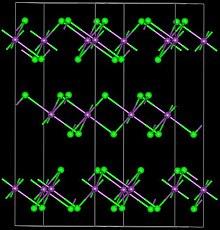 | |
| Names | |
|---|---|
| Other names ytterbium tribromide | |
| Identifiers | |
3D model (JSmol) | |
| ChemSpider | |
| ECHA InfoCard | 100.033.940 |
PubChem CID | |
CompTox Dashboard (EPA) | |
InChI
| |
SMILES
| |
| Properties | |
Chemical formula | YbBr3 |
| Molar mass | 412.77 g/mol |
| Appearance | white crystalline |
| Melting point | 677 °C (1,251 °F; 950 K)[1] |
| Boiling point | 1,800 °C (3,270 °F; 2,070 K)[1] |
| Structure | |
Crystal structure | Trigonal, hR24 |
| R-3, No. 148 | |
| Hazards | |
EU classification (DSD) (outdated) | not listed |
| NFPA 704 (fire diamond) | |
Except where otherwise noted, data are given for materials in their standard state (at 25 °C [77 °F], 100 kPa). | |
Ytterbium(III) bromide (YbBr3) is an inorganic chemical compound.
Refer to the adjacent table for the main properties of Ytterbium(III) bromide.
Conditions/substances to avoid in the use of Ytterbium(III) bromide are: moisture, water and oxidizing agents
References
- ^ a b Walter Benenson; John W. Harris; Horst Stöcker (2002). Handbook of Physics. Springer. p. 781. ISBN 0-387-95269-1.
